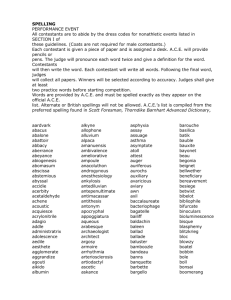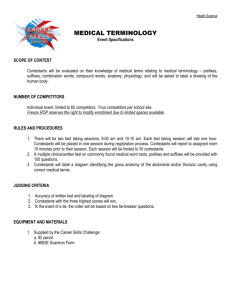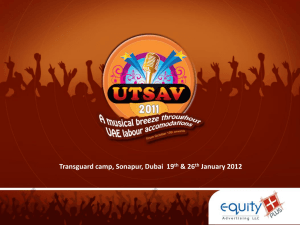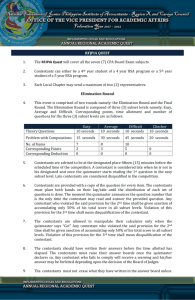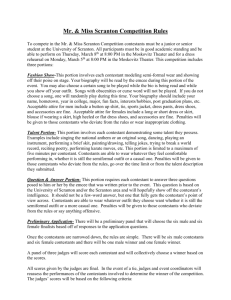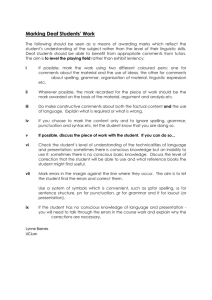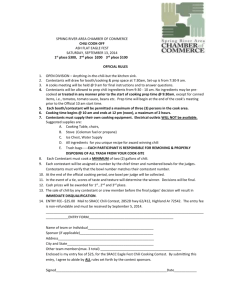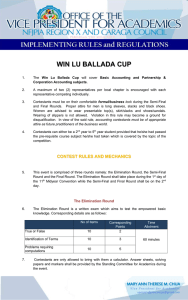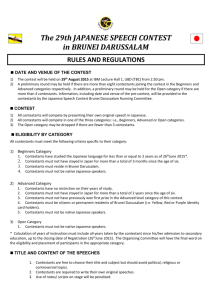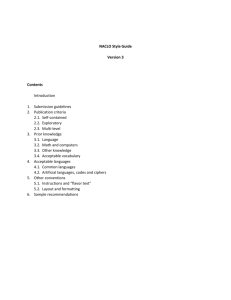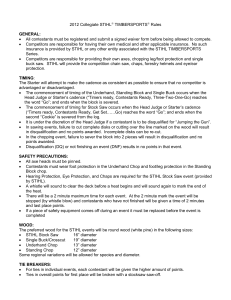Category Descriptions Document
advertisement
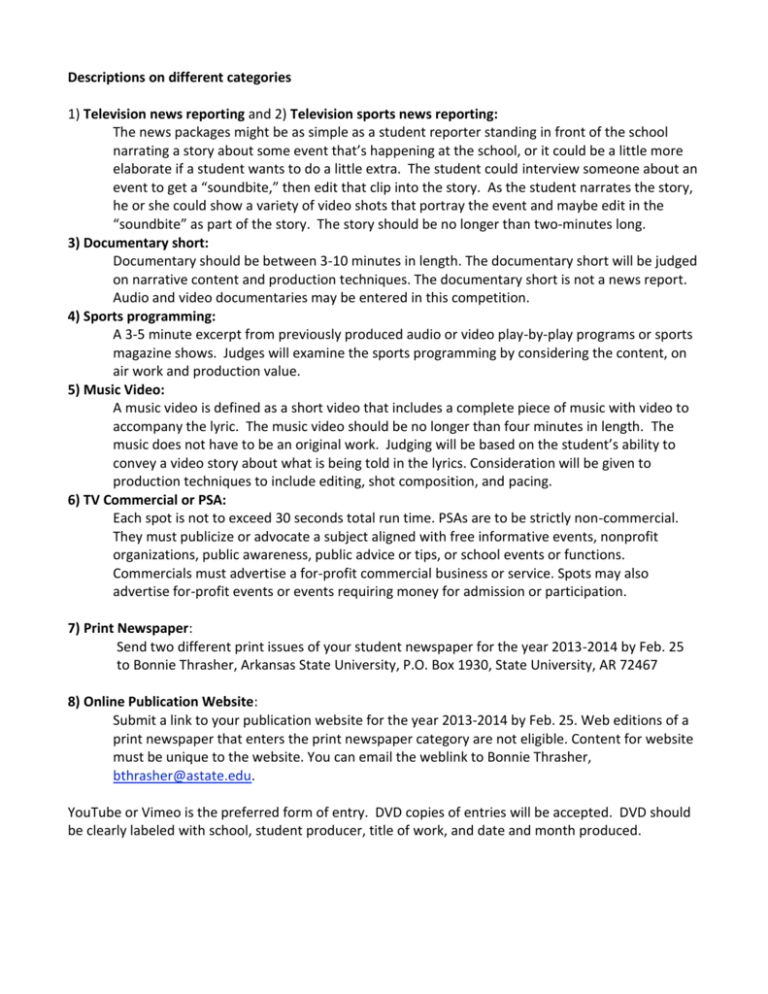
Descriptions on different categories 1) Television news reporting and 2) Television sports news reporting: The news packages might be as simple as a student reporter standing in front of the school narrating a story about some event that’s happening at the school, or it could be a little more elaborate if a student wants to do a little extra. The student could interview someone about an event to get a “soundbite,” then edit that clip into the story. As the student narrates the story, he or she could show a variety of video shots that portray the event and maybe edit in the “soundbite” as part of the story. The story should be no longer than two-minutes long. 3) Documentary short: Documentary should be between 3-10 minutes in length. The documentary short will be judged on narrative content and production techniques. The documentary short is not a news report. Audio and video documentaries may be entered in this competition. 4) Sports programming: A 3-5 minute excerpt from previously produced audio or video play-by-play programs or sports magazine shows. Judges will examine the sports programming by considering the content, on air work and production value. 5) Music Video: A music video is defined as a short video that includes a complete piece of music with video to accompany the lyric. The music video should be no longer than four minutes in length. The music does not have to be an original work. Judging will be based on the student’s ability to convey a video story about what is being told in the lyrics. Consideration will be given to production techniques to include editing, shot composition, and pacing. 6) TV Commercial or PSA: Each spot is not to exceed 30 seconds total run time. PSAs are to be strictly non-commercial. They must publicize or advocate a subject aligned with free informative events, nonprofit organizations, public awareness, public advice or tips, or school events or functions. Commercials must advertise a for-profit commercial business or service. Spots may also advertise for-profit events or events requiring money for admission or participation. 7) Print Newspaper: Send two different print issues of your student newspaper for the year 2013-2014 by Feb. 25 to Bonnie Thrasher, Arkansas State University, P.O. Box 1930, State University, AR 72467 8) Online Publication Website: Submit a link to your publication website for the year 2013-2014 by Feb. 25. Web editions of a print newspaper that enters the print newspaper category are not eligible. Content for website must be unique to the website. You can email the weblink to Bonnie Thrasher, bthrasher@astate.edu. YouTube or Vimeo is the preferred form of entry. DVD copies of entries will be accepted. DVD should be clearly labeled with school, student producer, title of work, and date and month produced. The following categories will be conducted on-site March 1, 2014 during Communications Day at ASU News Writing - Contestants will have one hour to write a hard news story from information provided in a press release. A person will be available to answer questions and/or give additional information as it relates to the information in the press release. The story will be scored on completeness, Associated Press Style, grammar and whether the news values (timeliness, impact, prominence, human interest, proximity, etc.) were applied in writing the news story. Photography - Contestants will have one hour to create a maximum of 24 photographs that tell a story about the events that are occurring at Communications Day. The photographs will be scored based on technical ability, composition and storytelling. TV Anchoring - The contestant has a minute to look over scripts for three or four reader (no video) stories (plus the hello and goodbye) to get familiar. Then the contestant is counted down and cued to read those stories from the Teleprompter to the studio camera as a news anchor. Video Promotion - Teams of up to three students will be given four hours to write, produce, and edit a 30-second promotional video spot for the assigned topic. The video will be scored based on creativity, technical quality, and message effectiveness. Feature Writing – Contestants will be given an hour to write a feature story based on information given to them. Stories will be judged on creativity, use of narrative structure and leads, and use of proper spelling, grammar and AP style. Newspaper Copy Reading - Contestants will have an hour to edit a story given to them for spelling, punctuation, grammar, AP style, clarity, redundancy and organization. The contestants will be score based upon the number of mistakes they correct. Broadcast News Writing - Each contestant is handed a sheet with a list of facts pertaining to a single story. The contestant is to write a 30-second broadcast news script for that story. Sports Writing – Contestants will have an hour to write a sports story about a particular sporting event. The contestants will be given stats sheets from the particular event and a list of quotes from coaches and participants. The resulting story will be judged on creativity, accuracy, grammar, punctuation, spelling, organization and how well lead communicates news of event to reader. Editorial Writing – Contestants will have an hour to write an editorial based on an issue. Editorials are based on facts, not just personal opinions. Editorials will be judged on clarity, grammar, spelling, logical conclusions based on the facts, and ability to persuade the reader to accept the opinion written. Radio Announcing — Each contestant will have a few minutes alone to practice reading a brief radio news script before entering a performance booth where they will be recorded. Performances will be judged on professional delivery factors such as articulation, pronunciation and interpretation. Headline Writing – Contestants will have an hour to write headlines for three articles. Headlines will be judged for accuracy, creativity, clarity, grammar, spelling and their ability to sell the story to the reader. Editorial Cartooning – A factsheet will detail an editorial expected to run in an upcoming student publication and contestants will have one hour to draw a suitable editorial cartoon to run with that editorial. Judges will consider how well the cartoon captures the issue and editorial viewpoint. Public Relations- Students who choose to participate in the Public Relations contest will be given a PR scenario and asked to develop ideas or concepts around that scenario. For example: students may be asked to create a special event theme/brochure, respond to a crisis via a media statement/release, come up with ideas for a charity project or use social media to create a “buzz” around a new product. Advertising- Students are assigned to design a creative, attractive, and interesting print advertisement for a given client. The entry is judged on the basis of originality, creativity, appropriateness, effectiveness, and clarity. Impromptu Debates- This debate format will challenge students to design and deliver arguments in a fun and creative extemporaneous format. No preparations necessary simply show up and be prepared to be involved in a competitive interactive dialogue. Extemporaneous Speaking- Students should come prepared with an extemporaneous informative speech topic. Using only a speaking outline or notes, students will deliver a 4-6 minute informative presentation that will be graded on preparation, organization, argument and delivery.
